Have you seen a black snake with yellow stripes, and are unsure of what type it is? There are many black and yellow striped snake in North America. Some have longitudinal stripes, and others are banded. The vast majority are not dangerous, but some species pose a risk to humans. These include the yellow-bellied sea snake (Hydrophis platurus) and the coral snake (Micrurus fulvius).
Most garter snakes are black or grey with at least one long, yellow stripe running from the neck to the tail. Some can be speckled or checkered or have different colored stripes. Although they have very mild venom, it is not strong enough to be a danger to humans.
We’re going to look in detail at black and yellow snakes that you can find throughout the USA. We’re going to explain what each one looks like, where it lives, and whether it’s venomous or not.
Black Snakes with Yellow Stripes Found in America
| Garter Snake: | Common across continental America | Very weak venom |
| Common Kingsnake: | Southern and Central America. Its range stretches from southern New Jersey in the east to Oregon in the west | Non-venomous |
| California Kingsnake: | The western U.S. including Oregon, California, Nevada, Utah, and Arizona | Non-venomous |
| Yellow Rate Snake: | Southeast US including Florida, Georgia, South Carolina, and North Carolina | Non-venomous |
| Ring-necked Snake: | Found throughout the eastern two-thirds of the US, from Canada to Florida | Very weak venom (not dangerous) |
| Gulf Salt Marsh Snake: | States that border the Gulf of Mexico: Texas, Louisiana, Mississippi, Alabama, and Florida | Non-venomous |
| Striped Racer: | California | Non-venomous |
| Western Shovelnose Snake: | California, Arizona, and Nevada | Non-venomous |
| Patch-nosed Snake: | California, Arizona, Nevada, New Mexico, and Texas | Non-venomous |
| Rosy Boa: | California and Arizona | Non-venomous |
| Coral Snake: | Southern US including Arizona, New Mexico, Texas, Arkansas, Louisiana, Mississippi, Alabama, Georgia, Florida, South Carolina, and North Carolina | Highly venomous |
| Yellow-Bellied Sea Snake: | California and Hawaii | Highly venomous |
Garter Snake (Thamnophis spp.)
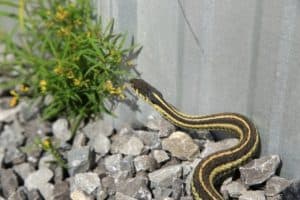
The garter snake is very common almost everywhere in the United States – it has even been reported in Alaska, according to the Alaska Herpetological Society.
There are 35 species of garter snake in the Thamnophis genus. Though not all of them are black-and-yellow striped, most of the most common species are. Some of these include:
- The common garter snake (Thamnophis sirtalis)
- The mountain garter snake (Thamnophis elegans elegans)
- The ribbon snake (Thamnophis sauritus)
- The plains garter snake (Thamnophis radix)
- The aquatic garter snake (Thamnophis atratus).
Appearance
Most species of garter snake are dark grey, dark brown, or black in color. They have at least one longitudinal yellow stripe running down their spine, from the head to the tail.
They usually have yellow or cream-colored bellies. Some garter snakes are speckled or checkered, may have more than one stripe, or may even have multicolored stripes. They are a thin, light-bodied snake. Usually, garter snakes remain under 4 feet long.
Habitat
Garter snakes can live almost everywhere in the U.S. Their habitat can range from populated areas such as farms to prairies, wetlands, forests, and even mountains.
They are hardy snakes that eat an extensive range of prey: rodents, birds, eggs, amphibians, lizards, and fish. They are so common that they are often misnamed “garden snakes,” due to their habit of showing up in yards.
Danger
Garter snakes have teeth and produce a mild venom. Their venom is toxic enough to kill small animals, such as mice and frogs, but it rarely does any damage to humans.
The Journal of Clinal Toxicology found that garter snake bites can result in swelling, pain, and bruising. However, this is usually the extent of the damage. They rarely bite humans, and cannot cause death or severe illness.
Common Kingsnake (Lampropeltis getula)
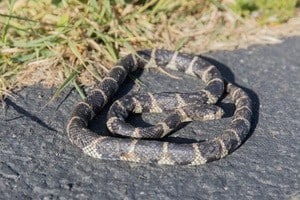
The genus Lampropeltis is a large group of over 45 non-venomous snakes, including kingsnakes and milk snakes.
They are extremely common across the U.S. and Mexico and come in a variety of colors and patterns.
The common kingsnake can be found across the southern and eastern states and is one of the most often seen species. Like all kingsnakes, they are ophiophages, feasting on other snakes as part of their natural diet.
Appearance
Common kingsnakes are medium-sized snakes. They regularly reach lengths of 3.5 feet, though the largest specimens have grown to over 7 feet long.
They are usually very dark brown or black in color, with many thin white, cream or yellow-colored “rings” from head to tail. These rings look similar to a chain linked along the body, giving them the nickname “chain snakes.”
Habitat
Widespread across most of the eastern and southern states, common kingsnakes can be found mostly in open areas such as grassland, deserts, and farms.
While they are not aquatic snakes, common kingsnakes are often found near sources of water such as swamps, streams, and rivers. This is due to the abundance of prey in that area.
Danger
Like almost all species of kingsnake, common kingsnakes are not aggressive towards humans. They are relatively docile, even when encountered in the wild. They are a snake that eats other snakes.
When they feel threatened, they attempt to retreat, sometimes releasing a foul-smelling musk. Bites do not tend to hurt very much and are not as dangerous as they have no venom.
California Kingsnake (Lampropeltis Californiae)
The California kingsnake is a close relative of the common or eastern kingsnake. It was once considered a subspecies but is now recognized as a species in its own right.
They look very similar, yet the California kingsnake is typically smaller and has slightly different markings. California kingsnakes are also found in a much narrower geographical area, mainly the west coast.
Appearance
California kingsnakes are one of the smallest species of kingsnake. They average around 2.5 to 3.5 feet in length, though they have been known to exceed 4 feet.
California kingsnakes range from medium brown to jet black in color, with white to yellow markings. These markings can either be horizontal bands, or longitudinal stripes.
Habitat
Found over a wide range of habitats, the California kingsnake encounters humans quite regularly.
It is mostly diurnal (active during the daytime) and inhabits woodland areas, grasslands, semi-arid areas and areas near to water. They can even be found in populated areas, so it’s not uncommon to find one in your backyard.
Danger
A threatened California kingsnake might vibrate its tail to imitate a rattlesnake, release a musk, strike or bite. Though they are not venomous, and their bites do not cause any damage, they can hurt. However, California kingsnakes are quite easily tamed, and often kept as pets.
Yellow Rat Snake (Pantherophis Aalleghaniensis Qquadrivittata)
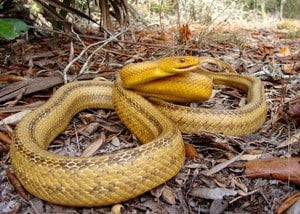
The yellow rat snake is a color variant of the eastern rat snake, often nicknamed the “black snake.”
While black snakes are common across the country, the yellow variant is only usually seen in the south-east U.S.
These harmless snakes are quite beneficial to us, as they feed on rodents that might cause humans problems.
Appearance
The yellow rat snake is bright to dark yellow, though in some regions it can look more orange. It has four dark stripes running down the length of its body.
The color of these stripes can be black, brown, or even olive. Rat snakes have lightly keeled scales, slender bodies, and narrow heads, and can grow up to 6.5 feet long.
Habitat
These snakes are not picky about where they live, as long as there is an abundance of prey for them to hunt. Rat snakes typically hunt small rodents and birds, and they can also eat bird eggs. You might find them on farms, in forests, fields or wetlands, or even in your backyard.
Danger
Rat snakes are constrictors and possess no venom. They can be frightened of humans and may demonstrate a defensive display if they feel threatened.
If severely provoked, they may bite. Though the bite may hurt and bleed, it will not cause any harm.
Ring-necked Snake (Diadophis Punctatus)
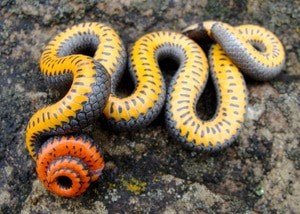
The ring-necked snake is quite commonly spotted throughout the US, Canada, and Mexico. There are several color variants, but a single ring around the neck can identify almost all of them.
These small snakes produce very mild venom, which does not pose a problem for most healthy humans.
Appearance
Most ring-necked snakes grow to a maximum of 1.5 feet. They are a snake that stays small. They have a dark body color which can be brown, grey or black. They have one single stripe around their necks, which is usually yellow or red (depending on the subspecies).
Their bellies are the same bright color as their neck-ring. While the ring-necked snake is not exactly striped, it can appear striped when viewed from the side.
Habitat
Found throughout the eastern two-thirds of the U.S., the ring-necked snake can often be found in forests and woodland. It tends to prefer wetter areas.
As the ring-necked snake is quite small, it prefers to live in areas with an abundance of places to hide (such as rocks, plants, and crevices in the ground).
Danger
When threatened by a potential predator, the ring-necked snake curls its tail up into a corkscrew, exposing the startling bright color of its underside. This serves as a warning to stay away.
They are rarely aggressive toward humans, though they may bite when provoked. A bite may trigger redness, itching, and slight swelling due to their mild venom, but it will not cause any severe harm.
Gulf Salt Marsh Snake (Nerodia Clarkii Clarkii)
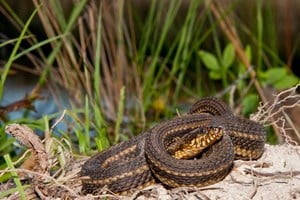
The gulf salt marsh snake is a small, aquatic colubrid native to the eastern United States. This snake mainly frequents the salt marshes, which are areas between the land and sea that are regularly flooded with saltwater.
It is a nocturnal snake, primarily preying upon aquatic creatures that inhabit tidal pools, such as fish, shrimp, and crabs. To avoid predators, it hides under debris and vegetation, and inside burrows dug by other animals such as crabs.
Appearance
The gulf salt marsh snake’s appearance can vary by region. Its primary color can range from reddish-brown to a dark grey, which can appear almost black.
Four yellowish stripes run down its body, two on each side, and its belly is spotted. Usually, salt marsh snakes do not exceed 2 feet in length.
Habitat
The gulf salt marsh snake can be found in the south of every state which borders the Gulf of Mexico. They’re only found in the marshy areas of land which border the sea.
There are other species of salt marsh snake found in different areas, but the gulf salt marsh snake is the only yellow-striped variety.
Danger
The gulf salt marsh snake is not venomous. It is also non-aggressive, and would likely try to escape if it saw a human coming. If a salt marsh snake bit you, it might hurt a bit, but it would not be dangerous.
Striped Racer (Masticophis Lateralis)
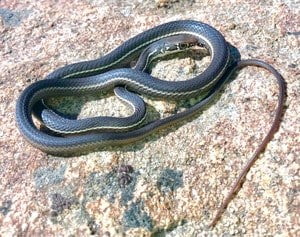
The striped racer snake is also known as the California whipsnake. Though it is a colubrid, it is not closely related to the eastern racer (Coluber constrictor), which belongs to a different genus.
It can only be found in California, where it is reasonably common, especially along the coast. As its name suggests, the striped racer is a very fast-moving snake and spends most of the day hunting for prey.
Appearance
People who spot the striped racer snake often mistake it for a garter snake, and it’s easy to understand why. Striped racers are long, slim, and black, with two long yellow to orange stripes and a yellow belly.
Unlike most garter snakes, though, it does not have a stripe running directly down its spine. Instead, there is one stripe on either side of the body.
Habitat
Occupying a wide range of habitats, striped racers can be found in woodland, foothills, rocky areas, and desert scrub. They inhabit anywhere that they can find a variety of prey, such as insects, mammals, lizards, and birds.
Danger
Striped racers are diurnal (active during the day), and cover a lot of ground, so humans often discover them.
They are relatively non-aggressive and prefer to escape if the opportunity arises. If cornered or picked up, they may bite; however, they possess no venom, so their bites are not dangerous.
Western Shovelnose Snake (Chionactis Occipitalis)
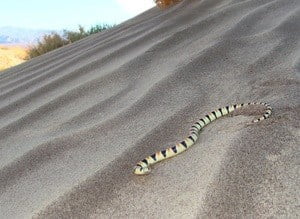
Found only in the deserts of California, Arizona, and Nevada, the nocturnal western shovelnose snake does not often encounter humans.
It is a non-confrontational and harmless colubrid and tends to spend most of the day hidden away underneath the sand. It comes out at night to hunt insects and scorpions.
Appearance
All western shovelnose snakes are smooth-scaled, slim and relatively small, reaching a maximum of 1.5 feet long.
Their background color is cream to yellow, and they have large dark brown or black saddles running across their bodies, which look like stripes. They have short, blunt snouts, to help them “swim” through the sand.
Habitat
Shovelnose snakes are most at home in the desert. They inhabit dry, sandy, and rocky areas with sparse vegetation.
During the day, they tend to bury themselves under the surface of the sand or between rocks, coming out to hunt at night. They are not usually found in areas populated by humans.
Danger
Western shovelnose snakes, and their close cousins the Sonoran shovelnose snakes, are non-venomous. They possess slightly irritating saliva which can cause minor swelling and itching, but that’s about it.
Bites are rare, as when confronted, shovelnose snakes tend to bury themselves in the sand or curl up in a ball rather than reacting aggressively.
Patch-nosed Snake (Salvadora spp.)

The term “patch-nosed snake” covers around seven separate species, all of which are endemic to western US and Mexico.
They get their name from a large, raised, triangular-shaped scale on the end of their snout, which can be slightly darker than the surrounding scales.
Appearance
The patch-nosed snake is long (up to 4 feet), thin and optimized for fast movement.
Its body is cream-colored, with one thick yellow stripe down the center of its back, and two black stripes on either side of the yellow one. Other species are paler in color with less vivid stripes. Their stripes can be rough-edged or uneven.
Habitat
Patch-nosed snakes can be found in a wide range of habitats, but their favorites include prairies, brushland, and forests near riverbeds. It primarily eats reptiles and reptile eggs, so it can be found anywhere that lizards and small snakes are abundant.
Danger
A diurnal snake, the patch-nosed snake is active during the day. When approached by a human, its first instinct is to try to escape.
It may feign-strike (with its mouth closed), or occasionally bite as a last resort. Its bite is completely nonvenomous, and it poses no danger to the health, though it may hurt slightly.
Rosy Boa (Charina Trivirgata)
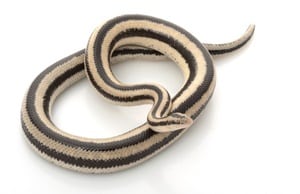
The rosy boa is one of only two species of boa (in the Boidae family) that can be found in the US. The other species is the rubber boa, belonging to the same genus.
Rosy boas are native to Mexico as well as the southwest U.S. and demonstrate a wide range of color variations depending upon location. They also make popular pets in the reptile-loving community.
Appearance
Rosy boas are medium in length, reaching up to 3.5 feet at their maximum. They are smooth-scaled with slit-like pupils and are not as heavy-bodied as other species in the boa family.
Depending on the area the snake is from, they may vary drastically in color. Californian rosy boas, for example, are often silvery grey, with olive-brown stripes. Boas in Arizona and Mexico, however, can appear more cream or yellowish, with dark brown to black stripes.
Habitat
Another desert-dwelling snake, the rosy boa inhabits arid and semi-arid areas with scattered vegetation. They like to remain close by to rocks and crevices where they can hide, should danger approach. Though they are listed as “least concern,” they are rarely encountered by humans.
Danger
The rosy boa is one of the least dangerous snakes in the world. It is exceptionally slow-moving and mellow-natured. Most rosy boas do not show any aversion to being approached or even handled.
If they feel threatened, they are likely to curl up into a ball. They are nonvenomous, and bites are overwhelmingly rare.
Coral Snake (Micruroides and Micrurus spp.)
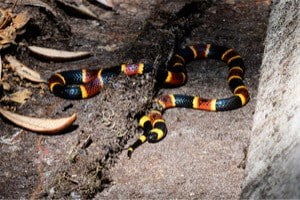
There are three species of highly venomous coral snake found in the US: the Eastern coral snake (Micrurus fulvius), the Texas coral snake (Micrurus tener), and the Sonoran coral snake (Micruroides euryxanthus).
Though they don’t commonly encounter humans, they can be quite dangerous, so it’s always worth knowing how to recognize them.
Appearance
Coral snakes are long and slim, with narrow heads. All three US-native coral snakes have black, yellow and red bands along their bodies. The color pattern always goes black-yellow-red-yellow, so red and black are never touching.
The red bands usually stop at the tail, so the tail is black with yellow stripes. Anerythristic coral snakes, lacking the red pigment altogether, can also exist. These snakes appear purely black and yellow.
Habitat
The southernmost states, from Arizona, stretching to North Carolina, are home to coral snakes. Eastern and Texas coral snakes prefer to spend time mostly in forests and wooded areas, often near water.
The Sonoran coral snake (of Arizona and New Mexico) also inhabits arid regions, such as desert scrub and rocky areas. They all like to hide under leaves and rocks, and in burrows, to avoid predators.
Danger
Coral snake bites are rare, as they are quite reclusive animals. When approached, coral snakes almost always try to escape before resorting to biting. If you do take a bite, however, you’re in for a trip to the hospital.
According to the Journal of Venomous Animals and Toxins, coral snake bites can result in respiratory distress, paralysis, and even death if antivenin is not administered.
Yellow-Bellied Sea Snake (Hydrophis Platurus)
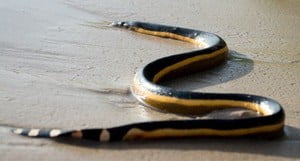
The yellow-bellied sea snake is entirely aquatic. It is part of the sea snake family (Hydrophiinae), containing over 50 species. Nearly all of them are highly venomous.
The yellow-bellied sea snake is the only sea snake that can be spotted near the US, as most other species are confined to tropical Asian and Australian waters.
Usually, the only state that it approaches is Hawaii. However, according to National Geographic, yellow-bellied sea snakes have been found off the coast of California.
Appearance
The yellow-bellied sea snake has a very streamlined appearance. It has a narrow body, and its tail is shaped almost like an oar, helping it to propel itself through the water.
The top side of the snake is completely black, and the underside (belly) is a vivid, bright yellow. Its pattern is technically not striped, but it looks striped when viewed from the side.
Habitat
Of course, as its name suggests, the yellow-bellied sea snake lives in the sea. Unlike some other species of aquatic snake, it cannot move around on land, so you’ll never find it on the shore (unless it accidentally washes up on a beach).
It is always found in the sea or trapped in tide pools. The yellow-bellied sea snake does not have gills, so it must come to the surface to breathe.
Danger
It’s rare to come across a yellow-bellied sea snake off the coast of the U.S. When they do encounter humans, they are placid and will swim away.
They do bite if picked up, so you should never attempt to handle one. Their bites should be considered a medical emergency as they are extremely venomous.
Black Snakes with Yellow Stripes List
| Garter Snake: | Common across continental America | Very weak venom |
| Common Kingsnake: | Southern and Central America. Its range stretches from southern New Jersey in the east to Oregon in the west | Non-venomous |
| California Kingsnake: | The western U.S. including Oregon, California, Nevada, Utah, and Arizona | Non-venomous |
| Yellow Rate Snake: | Southeast US including Florida, Georgia, South Carolina, and North Carolina | Non-venomous |
| Ring-necked Snake: | Found throughout the eastern two-thirds of the US, from Canada to Florida | Very weak venom (not dangerous) |
| Gulf Salt Marsh Snake: | States that border the Gulf of Mexico: Texas, Louisiana, Mississippi, Alabama, and Florida | Non-venomous |
| Striped Racer: | California | Non-venomous |
| Western Shovelnose Snake: | California, Arizona, and Nevada | Non-venomous |
| Patch-nosed Snake: | California, Arizona, Nevada, New Mexico, and Texas | Non-venomous |
| Rosy Boa: | California and Arizona | Non-venomous |
| Coral Snake: | Southern US including Arizona, New Mexico, Texas, Arkansas, Louisiana, Mississippi, Alabama, Georgia, Florida, South Carolina, and North Carolina | Highly venomous |
| Yellow-Bellied Sea Snake: | California and Hawaii | Highly venomous |
If you find a black snake with long yellow stripes in your backyard, it’s most likely a garter snake. A black snake with yellow rings or bands will likely be a kingsnake of some kind, depending on where you are in the country.
No matter what it is, it probably won’t be dangerous. The only highly venomous black and yellow snakes are yellow-bellied sea snakes (which can’t move on land) and coral snakes (which usually have red bands too, at least in the US).
That being said, this guide does not apply to countries in other parts of the world. South America, Asia, and Australia are home to several different black-and-yellow striped snakes that are dangerous to humans (such as the banded krait).
To be on the safe side, whenever you encounter a wild snake, admire it from a safe distance. Remember that even non-venomous snakes can bite if provoked, and while it may not be dangerous, it can still hurt.

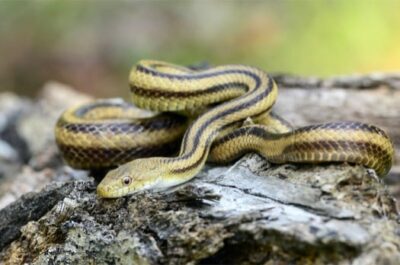
Thank you so so much for answering my question in the beginning short paragraph. It was a low venous, not dangerous, possible garden sake. I usually just rush them away from my area and hope they do not return. Normally I never seen them again. When my 3 daughters were little. I never let them climb my 12 ft away mountain side hill behind my home. When they all left my house, I hired young men to help me clean my backyard hill, built a 32 steps sliding , with 6 steps00–then 6 ft flat walking area to the ncxt step sets of 16 steps, then 6 long flat form to my last to last 8 steps and you arrive on top of the hill with a cement walking area of which is 16 feet long…I have 3Pole Street lights in the beginning of the half way to the 32 steps and the top of the steps , same street light Pole, and the ending of the cement walkway. I have individual polee lights, `16 inch high around the garden to keep animals away, and scaring crow figures in my yard. I have water fountains for the birds to nest near by. i have garden and plant design too. But yes I have a shed and chairs to seat with guest, and mosquito plants around. So yes, animals like snakes, rabbits, squirrels, wild mountain lions-or foxes show up too, PIGs, or Boars, show up too. Deer and Turkey with their babies, like the boars have babies travel near my landscape yard too. So yes I read your hold article and took notes on the Texas snakes..I appreciate your expertise on snakes.